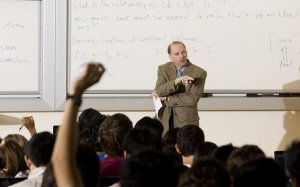Oct 20 2009
Chemist Michael Therien works at the interface of light and matter, as when sunlight shines on a leaf. "We make structures of matter, such as nanoscale objects that do interesting things when they interact with light," said Therien, a professor of chemistry who has just moved his research group to Duke from the University of Pennsylvania.
 Duke University Photography
Duke University Photography
During his 18 years at Penn, Therien worked on nanoscale fluorescent probes only 100 billionths of a meter wide that can be injected into the body to help identify developing cancers. When activated by near-infrared laser beams that can penetrate centimeters below the skin's surface, these probes are able to "flash" the locations of budding new tumors.
"This is a technology the National Cancer Institute hopes to enable within the next decade," he said. "Laser light-based cancer detection technologies would be cheap and portable compared to established diagnostic technologies like Positron Emission Tomography (PET) or Magnetic Resonance Imaging (MRI); it is also important to underscore that PET and MRI are also not readily available to much of the world's population."
Therien is also creating "smart filters" that let in low-intensity light near-infrared light but block high-intensity flashes. "Optical limiters such as these would be useful in applications ranging from safer aircraft windscreens to a variety of security sensor technologies," he said. "For example, a pilot needs to see his environment but cannot be blinded by an intense pulse of laser light."
Another longstanding goal is to make new kinds of solar cells, "ideally out of inexpensive organic materials," he said. "This is an area of research I've been involved with since the beginning of my academic career."
Biology already does that through photosynthesis, but "Mother Nature remains a lot smarter than we are," he added. "She has had millions of years of evolution to guide the way."
A fourth target of interest is "building proteins with functions that have no parallel in Nature," he said. Examples would include unique synthetic energy-harvesting proteins and artificial proteins that would serve as building blocks for new types of electronic and optical materials.
Therien's path to research began early. "I've always enjoyed science," he said. "It may have started with a Christmastime gift of a chemistry set. I suspect that a 1960s chemistry set was more exciting than one you would purchase today. I remember the thrill of making various colored dyes and fireworks. As I became more interested in chemistry, I wanted to understand how life works at a very fundamental level and why molecules do what they do."
He began his faculty career as an assistant professor at Penn in 1990. By 1997 he was promoted to full professor and in 2002 was named the Alan G. MacDiarmid Professor there. Around that time he began a now-longstanding collaboration with the University of Leuven in Belgium in the area of optical materials.
Therien spent a transition year that ended last July, shuttling between Leuven and his new laser and synthetic chemistry laboratories in Duke's French Family Science Center.
"I've known a number of people at Duke for a long time, and about six years ago they began the process of talking to me about the possibility of coming here," he said. "Duke had many great attractions in addition to the Chemistry Department, including the School of Medicine and the Fitzpatrick Center for Photonics. Another great selling point was Duke's commitment to making biomedical imaging a priority research area for development on campus. I know there will be multiple opportunities for growing my research program in new directions."
Therien also is committed to instruction. He is showing it by teaching first year chemistry, a program previously made famous by the legendary James Bonk, who taught it for more than 40 years.
"I love doing demonstrations and letting students get their hand's dirty when possible," he said. "(Bonk's) are pretty big shoes to fill, but the current teaching model for first year chemistry offers a wide variety of lecture options and has multiple faculty and staff involved.
"I am currently teaching an accelerated course over one semester for entering freshmen with strong chemistry backgrounds. Teaching first year chemistry is underscored by the challenge to educate and entertain, and striking the right balance is not always straightforward. But I hope that my course will help turn some young people on to a career in science."
He will also be co-teaching a graduate course in the roles of metals in bioorganic chemistry with Alvin Crumbliss, Duke's dean of natural sciences.
Therien's wife, Zsuzsanna, is a Hungarian-born radiologist whom he met when he was working in Philadelphia and she was doing a fellowship in New York City. They have two sons, aged 11 and 12.
"I like living in Durham and being close to my laboratories at Duke," he said. His spare time "mainly involves chasing two boys around," he added. "They play competitive baseball 10 or 11 months of the year. That's their passion, but they also manage to play play a lot of soccer and tennis.